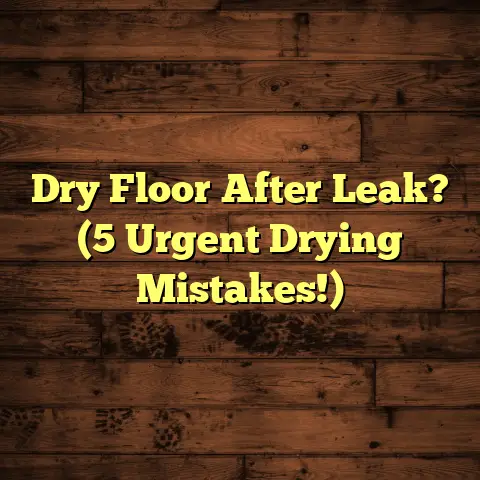Epoxy Over Wood Floors: Good Idea? (3 Risks!)
What if you could wave a magic wand and turn your old, scratched wood floors into a glossy, modern masterpiece with just one application?
Sounds tempting, right?
That’s the allure of epoxy flooring, a trendy option that promises a sleek look and incredible durability.
But hold on a second!
Before you jump on the epoxy bandwagon, let’s dive deep into whether it’s really a good idea to slather epoxy over your existing wood floors.
Trust me, there are some hidden risks you need to know about.
1. Understanding Epoxy Flooring
So, what is epoxy flooring anyway?
Think of it as a super-strong, two-part liquid that, when mixed, creates a hard, durable, and chemical-resistant surface.
Chemically speaking, epoxy resins are polymers that cross-link during the curing process.
This cross-linking is what gives epoxy its incredible strength and resistance to things like scratches, stains, and even some chemicals.
You’ll find epoxy in all sorts of places, from garage floors and industrial warehouses to trendy restaurants and even some homes.
Its popularity comes from its versatility, resilience, and the ability to customize it with different colors, patterns, and even embedded objects.
Now, when it comes to putting epoxy over wood, that’s where things get a little more complicated.
The prep work is crucial.
We’re talking about sanding, cleaning, and potentially priming the wood surface to ensure the epoxy adheres properly.
Skip any of these steps, and you’re asking for trouble.
2. Benefits of Epoxy Over Wood Floors
Okay, let’s be fair. There are some potential upsides to epoxying your wood floors.
Aesthetics: Epoxy can give your floors a seriously
modern and stylish look.
Imagine a seamless, glossy
surface that reflects light and makes your space feel
bigger.
Plus, you can customize the color and even
add decorative flakes or metallic pigments for a truly
unique look.Water Resistance: Wood and water are not friends.
Epoxy, on the other hand, is like a superhero when it
comes to water resistance.
It creates a barrier that
prevents water from seeping into the wood, which can
be a lifesaver in kitchens, bathrooms, or basements.Easy Cleaning: Say goodbye to scrubbing!
Epoxy
surfaces are incredibly easy to clean.
A quick sweep
and a damp mop are usually all you need to keep them
looking their best.Protection: Epoxy acts like a shield, protecting your
wood floors from everyday wear and tear.
Scratches,
scuffs, and stains are less likely to penetrate the
epoxy, keeping your floors looking newer for longer.
For high-traffic areas, this can be a major selling point.
I’ve seen homeowners transform their dull, outdated wood floors into stunning, eye-catching surfaces with epoxy.
It’s like giving your floors a complete makeover!
But, as with any makeover, it’s essential to consider the potential risks.
3. Risk 1 – Adhesion Issues
Alright, let’s get to the nitty-gritty.
The first, and perhaps biggest, risk of putting epoxy over wood floors is adhesion.
Think of it this way: epoxy is like a really strong glue, but glue only works if it can properly stick to the surface.
Several factors can cause the epoxy to fail to bond correctly to the wood:
Moisture Content: Wood is a natural material, and it
contains moisture.
If the wood is too damp when you
apply the epoxy, the epoxy won’t be able to adhere
properly.
The moisture can create a barrier, preventing
the epoxy from forming a strong bond.- Example: I once worked on a project where the
homeowner insisted on applying epoxy over wood
floors that hadn’t fully acclimated to the room’s
humidity.
Within a few months, the epoxy started
peeling up in large sections.
It was a costly
mistake.
- Example: I once worked on a project where the
Surface Preparation: This is HUGE.
If you don’t
properly prepare the wood surface, the epoxy simply
won’t stick.
That means thoroughly sanding the wood
to create a rough surface for the epoxy to grab onto,
cleaning it to remove any dust, dirt, or grease, and
potentially applying a primer to improve adhesion.- Industry Data: According to the National Wood
Flooring Association (NWFA), proper surface
preparation is cited as the leading factor in
successful flooring installations, including those
involving coatings like epoxy.
- Industry Data: According to the National Wood
Temperature: Epoxy is finicky when it comes to
temperature.
If it’s too cold, the epoxy won’t cure
properly, and the bond will be weak.
If it’s too hot,
the epoxy might cure too quickly, leading to bubbles or
other imperfections.- Example: One time, I was applying epoxy in a
garage during the summer, and the temperature
inside was well over 90 degrees.
The epoxy started
to set up almost immediately, making it impossible
to get a smooth, even finish.
- Example: One time, I was applying epoxy in a
When epoxy doesn’t adhere properly, you’ll start to see problems like:
-
Peeling: The epoxy will start to lift away from the
wood, creating unsightly patches. -
Bubbling: Air or moisture trapped beneath the epoxy
can cause bubbles to form, ruining the smooth surface. -
Cracking: A weak bond can lead to cracks in the
epoxy, especially in high-traffic areas. -
Delamination: This is when the epoxy completely
separates from the wood, leaving you with a mess to
clean up.
I’ve seen countless projects go wrong because of poor adhesion.
It’s not pretty, and it can be incredibly frustrating and expensive to fix.
4. Risk 2 – Moisture Trapping
Okay, let’s talk about another major concern: moisture.
Wood is a porous material, meaning it has tiny little holes that can absorb and release moisture.
That’s just the nature of wood.
When you seal wood with epoxy, you’re essentially creating a barrier that prevents moisture from escaping.
This can lead to a whole host of problems:
Mold Growth: Trapped moisture creates the perfect
environment for mold to thrive.
Mold can not only
damage your wood floors but also pose a serious health
risk, especially for people with allergies or respiratory
problems.- Health Data: The Environmental Protection Agency
(EPA) warns that mold growth can lead to a variety
of health issues, including allergic reactions,
asthma attacks, and other respiratory problems.
- Health Data: The Environmental Protection Agency
Wood Rot: If moisture is trapped for an extended
period, it can cause the wood to rot.
This weakens the
structural integrity of your floors and can eventually
lead to costly repairs.- Industry Insight: Wood rot is a common problem
in areas with high humidity or where water damage
is prevalent.
Regular inspections and proper
ventilation can help prevent wood rot.
- Industry Insight: Wood rot is a common problem
Structural Damage: In severe cases, trapped
moisture can cause the wood to warp, buckle, or even
collapse.
This can compromise the safety of your home.- Real-Life Example: I inspected a home where
epoxy had been applied over wood floors in a
basement.
The basement had a history of minor
leaks, and the epoxy trapped the moisture, leading
to significant wood rot and structural damage.
The
homeowner had to replace a large section of the
floor.
- Real-Life Example: I inspected a home where
The key here is to ensure that the wood is completely dry before applying epoxy.
This might involve using a moisture meter to check the moisture content of the wood and allowing it to acclimate to the room’s humidity for several days or even weeks.
- Pro Tip: A moisture meter should read below 12%
before applying epoxy.
Even then, there’s still a risk of moisture becoming trapped over time, especially if there are any leaks or plumbing issues.
I always advise homeowners to be extra cautious about moisture control when considering epoxy over wood floors.
5. Risk 3 – Long-Term Maintenance Challenges
Finally, let’s talk about what happens after the epoxy is applied.
While epoxy is incredibly durable, it’s not indestructible.
Over time, it can be susceptible to:
Scratches: While epoxy is scratch-resistant, it’s not
scratch-proof.
Heavy furniture, pets, or even just
regular foot traffic can cause scratches over time.-
Chips: If something heavy is dropped on the epoxy
surface, it can chip or crack. -
Wear: In high-traffic areas, the epoxy can wear down
over time, losing its glossy finish.
The problem is, repairing epoxy surfaces is not as easy as repairing traditional wood finishes.
With wood floors, you can usually sand down the surface and apply a new coat of varnish or polyurethane.
With epoxy, it’s a bit more complicated.
Reapplication: To properly repair damaged epoxy, you
often need to sand down the entire surface and apply
a new coat of epoxy.
This can be a time-consuming
and expensive process.-
Touch-Ups: Spot repairs can be difficult to blend in
seamlessly, especially if the original epoxy had any
custom colors or patterns. -
Complexity: Maintaining epoxy-coated wood floors can
be more complex than maintaining untreated wood
floors.
I’ve seen homeowners struggle to maintain their epoxy floors, especially in homes with pets or young children.
Scratches and chips are inevitable, and repairing them can be a real headache.
- Homeowner Story: A client of mine had epoxy floors
installed in her kitchen.
She loved the look, but after
a year, she noticed several scratches and a small chip
near the sink.
She tried to repair them herself, but
the touch-up job looked uneven and didn’t match the
original finish.
She ended up hiring a professional to
reapply the epoxy to the entire kitchen floor.
The long-term maintenance challenges are definitely something to consider before taking the plunge with epoxy over wood floors.
Conclusion
So, is epoxy over wood floors a good idea?
Well, it depends.
As we’ve discussed, there are some potential benefits, such as enhanced aesthetics, water resistance, and ease of cleaning.
But there are also some significant risks to consider:
-
Adhesion Issues: Poor bonding between the epoxy
and wood can lead to peeling, bubbling, and cracking. -
Moisture Trapping: Sealing wood with epoxy can trap
moisture, leading to mold growth, wood rot, and
structural damage. -
Long-Term Maintenance Challenges: Repairing
scratches, chips, and wear on epoxy surfaces can be
difficult and expensive.
Before you make a decision, I urge you to weigh the pros and cons carefully.
Consider your lifestyle, your budget, and your tolerance for risk.
And most importantly, consult with a qualified flooring contractor who can assess your specific situation and provide expert advice.
Is the sleek, modern look of epoxy worth the potential headaches down the road?
That’s a question only you can answer.





